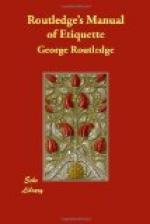2nd four bars.—Polka Mazurka, with right foot to the right, and turn half round. Cellarius step, with left foot to the left. Fall on right foot, keeping it behind; glissade with left foot, bringing it behind.
Repeat from beginning, which completes the sixteen bars of second half of the figure.
Lady does the same steps, with order of feet reversed.
* * * * *
XVII.—THE VALSE A TROIS TEMPS
Twenty years ago, the Valse (or, as it was then pronounced, Waltz) was a stately measure, danced with gravity and deliberation. Each couple wheeled round and round with dignified composure, never interrupting the monotony of the dance by any movements forward or backward. They consequently soon became giddy, although the music was not played above half as fast as the valse music of our day. We are bound to admit that this stately fashion of waltzing was infinitely more graceful than the style which has superseded it. But, having confessed so much, we may venture to add that the Valse, as danced by the present generation, possesses a spirit, lightness, and variety quite unknown to its stately predecessor.
The old Waltz was introduced into this country from Germany, where it has always been the favourite dance of the people in all ranks and conditions. But, although we adopted the step of their national waltz, we so entirely altered the time, that it became in our hands a totally different dance, which the Germans themselves would have found it difficult to recognize. At that period, “fast dancing” was unknown in England, and would have been regarded as highly indecorous.
At its first introduction, the Waltz was received with great mistrust by the older portion of the community. If it was to be tolerated at all in correct society, it must at least be danced in a deliberate manner, consonant with the dignity of the English character. It was, therefore, taken at half its original temps; it ceased to be the giddy, intoxicating whirl in which the Germans delight, and subsided into the comparatively insipid and spiritless affair known thirty years ago as the “German Waltz.”
We have already seen how complete was the revolution effected by the Polka in these old-fashioned ideas. But, although we cannot regret the introduction of a more animated style of dancing, we are sorry that the old Waltz has been so entirely given up. When restored to its original temps, the Valse a Trois Temps is nearly as spirited as the Valse a Deux; and twice as graceful. It has the additional advantage over the latter, that it contains in each bar three steps to three beats of the time; whereas the Deux Temps, as its name implies, numbers only two steps in a bar of three notes; and is thus incorrect in time. We venture to predict that the old Waltz will, at no distant day, be restored




